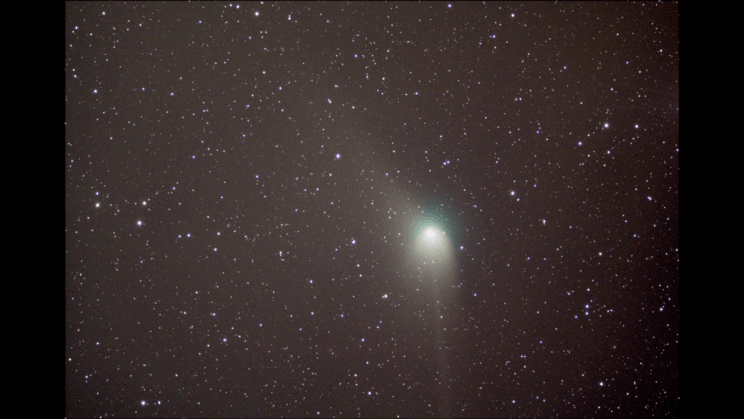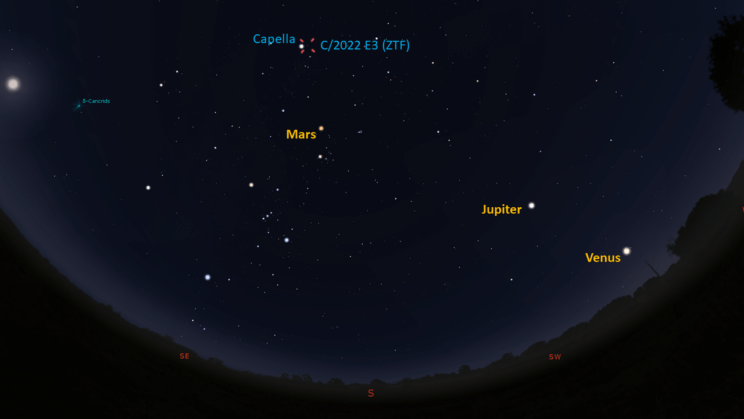This is the Saint Louis Science Center’s NIGHT SKY UPDATE for the week of Friday, February 3, 2023.
Information updated weekly or as needed.
Times given as local St. Louis time which is Central Standard Time (CST). For definitions of terminology used in the night sky update, click the highlighted text. If relying on times posted in Universal Time (UT), St. louis is -6 hours when CST.
Public Telescope Viewings
As part of the Saint Louis Science Center’s First Fridays, weather permitting, the St. Louis Astronomical Society and the Science Center will set up a number of telescopes outdoors and be on-hand to answer your questions. Telescope viewing begins once it is dark. Regardless of the weather on March 3, join us indoors in our planetarium theater for “The Sky Tonight”. Showtime is at 7 p.m.
Observing Highlight of the Week

Image of comet C/2022 E3 (ZTF) taken by Randy Harrison. The green color seen in the coma of the comet is caused by diatomic carbon. Image credit: Randy Harrison.
Our highlight for the week will once again be the comet C/2022 E3 (ZTF). The comet has likely reached its peak magnitude and will now begin to fade as the comet moves away from Earth. C/2022 E3 (ZTF) remains a nice target in binoculars, but that will change near the end of February.
This week, C/2022 E3 (ZTF) spends most of the week passing through the constellation Auriga. By the end of the week, it will pass into the constellation Taurus as the comet appears near Mars in the sky. Views of C/2022 E3 (ZTF) will become more challenging each night as it has passed by Earth and is now moving away from us. The comet should remain a binocular target for the first half of February, but models suggest a quick drop in magnitude by the end of the month. By March, C/2022 E3 (ZTF) is expected to have a magnitude of 8.5. At this magnitude you will need a telescope to see the comet.
Further complicating things, the Moon has become a problem for finding the comet as bright moonlight is making it harder to see. Moonlight will continue to be problematic this week as the Moon reaches full moon on February 5, 2023. Those new to observing comets will likely have a tough time spotting C/2022 E3 (ZTF) due to this interference and the declining magnitude.
There are a few upcoming dates that will make finding the comet easier. On February 5, 2023, C/2022 E3 (ZTF) will be seen a little over 1° west of the bright star Capella around 6:30 p.m. As the night progresses, you will see the comet shift northwest of Capella.
On February 10 and 11, C/2022 E3 (ZTF) appears near Mars. On the 10th, the comet will appear northeast of Mars and on the 11th, it will be southeast of Mars. Those using binoculars should be able see Mars and the comet within one field of view.
The last date to mention is February 14, 2023. On this night, C/2022 E3 (ZTF) will appear near the bright star Aldebaran. This orange giant is the brightest star in the constellation Taurus. If using binoculars, the star and the comet should be visible together. But by this date, models are already projecting that the comet will have faded to 7th magnitude.
Current estimates from experienced observers place C/2022 E3 (ZTF) magnitude between 5.0 and 6.5. The last time I saw the comet I would place it at 6.0 magnitude. The appearance has also started to change in that it looks a bit elongated compared to previous weeks. Perhaps C/2022 E3 (ZTF) still has some surprises left to show us but it is likely that over the next few weeks C/2022 E3 (ZTF) will continue to fade dropping out of range of binoculars. Get your views in while you still can.
The Sun and Moon

The Moon as seen from the International Space Station, on July 31, 2011.
Credit: NASA
Sunrise is at 7:05 a.m. on Friday, February 3 and sunset is at 5:25 p.m. providing us with nearly 10.5 hours of daylight. Even after sunset, light from the Sun will dimly illuminate our sky for roughly 1 hour and 30 minutes. This period is called twilight, which ends around 6:56 p.m. this week. For those with a sundial, local noon occurs around 12:14 p.m. this week.
| Day | Sunrise | Sunset | ||||||||||
|---|---|---|---|---|---|---|---|---|---|---|---|---|
| 3-Feb | 7:05 a.m. | 5:25 p.m. | ||||||||||
| 4-Feb | 7:04 a.m. | 5:26 p.m. | ||||||||||
| 5-Feb | 7:03 a.m. | 5:27 p.m. | ||||||||||
| 6-Feb | 7:02 a.m. | 5:28 p.m. | ||||||||||
| 7-Feb | 7:01 a.m. | 5:29 p.m. | ||||||||||
| 8-Feb | 7:00 a.m. | 5:31 p.m. | ||||||||||
| 9-Feb | 6:59 a.m. | 5:32 p.m. | ||||||||||
| 10-Feb | 6:58 a.m. | 5:33 p.m. | ||||||||||
| 11-Feb | 6:56 a.m. | 5:34 p.m. |
Moon
Moonrise for Friday, February 3 was at 3:23 p.m. and moonset occurred at 6:50 a.m. on the following day. Friday, February 3, the Moon will exhibit a waxing gibbous phase with 96% of the lunar disk illuminated. Full moon occurs on February 5, 2023, at 12:29 p.m.
International Space Station (ISS) Observing

There are two visible passes of ISS over St. Louis this week. The table below contains information related to these evening passes. ISS will return to St. Louis skies on February 13, 2023, as it returns to morning passes.
Catch ISS from St. Louis starting Friday, February 3
| Date | Starts | Max. altitude | Ends | |||||||
|---|---|---|---|---|---|---|---|---|---|---|
| Time | Alt. | Az. | Time | Alt. | Az. | Time | Alt. | Az. | ||
| 04 Feb | -2.2 | 18:31:26 | 10 | WNW | 18:34:36 | 36 | SW | 18:37:45 | 10 | SSE |
| 06 Feb | -0.5 | 18:33:34 | 10 | WSW | 18:35:01 | 12 | SW | 18:36:27 | 10 | SSW |
Magnitude (Mag): The Measure of brightness for a celestial object. The lower the value is, the brighter the object will be.
Altitude (Alt): The angle of a celestial object measured upwards from the observer’s horizon.
Azimuth (Az): The direction of a celestial object, measured clockwise from an observer’s location with north being 0°, east being 90°, south being 180° and west being 270°.
For information about ISS flyovers and other visible satellites, visit www.heavens-above.com
Detailed information regarding all unmanned exploration of our universe, missions past, present, and planned, can be found at Jet Propulsion Laboratories:
The Visible Planets

Looking south at 6:30 p.m. on February 5, 2023. Credit: Stellarium, EG
This week, three naked eye planets are visible. Venus and Jupiter are found in the southwest after sunset. Mars is found overhead after sunset.
Venus
Venus is climbing out of the Sun’s glare as it starts another an evening apparition. Once high enough above the horizon, Venus will be a bright target in the west after sunset until August 2023 when it approaches inferior conjunction. This week, look for Venus in the southwest about 20 minutes after sunset. Venus sets at 7:24 p.m.
Mars
Mars now rises before sunset becoming visible once it is dark. Look for it overhead about 30 minutes after sunset. Mars sets by 3:02 a.m.
Jupiter
Now past opposition, Jupiter will be visible about 30 minutes after sunset. Jupiter reaches superior conjunction on April 11, 2023. As we progress towards this date, we will see Jupiter slowly wander towards the Sun. Jupiter now sets at 9:32 p.m.
James S. McDonnell Planetarium
Night Sky Update: February 3 – 11, 2023






